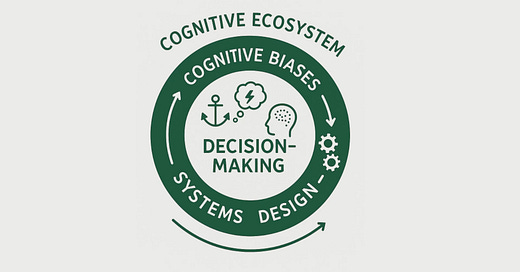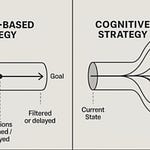Think of this as your cognitive ecosystem—not just a diagram, but your mind's operating system. And you're already running it.
At the center is decision making. It’s not isolated, not pure—it’s reactive and constantly shaped by everything around it. Nearby are your cognitive biases: anchoring, status quo, pattern-seeking. These aren’t flaws or bugs; they’re brain shortcuts—efficiency hacks used to filter and frame information quickly. They can distort, yes, but they can also accelerate. In the right system, they can help you think smarter.
These biases interact with system design—our defaults, cues, and workflows. These elements subtly and systematically shape how choices happen. We’re not forcing decisions—we’re nudging them, quietly and automatically.
When we zoom out, we see the whole cognitive ecosystem. If we're too close, we only see the loudest signal, the anchor, or the distraction clouding our judgment. But zoomed out, it’s clear: everything feeds everything. Decisions shape biases. Biases filter our interaction with systems. Systems set the stage for the next decision. It’s not linear—it’s recursive, layered, and alive.
The real shift? We don’t need more willpower. We need our feedback loops to work better together. Stop blaming the individual. Start designing the environment. Don't override your biases—put them to work.
This isn't about control. It's about clarity. It’s how you build a brain-aligned system. Strategy starts from the inside out. The goal isn’t more willpower—it’s creating better loops.








Share this post